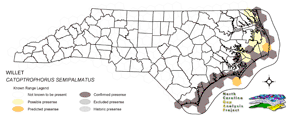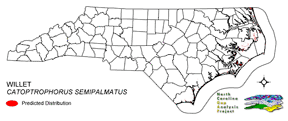
| Taxa: |
| Order: |
| Family: |
| Aves |
| Charadriiformes |
| Scolopacidae |
| NatureServe Global Rank: |
| NatureServe State (NC) Rank: |
| G5 |
| S4B,S4N |
| Federal Status: |
| NC State Status: |
| --- |
| --- |


| Land Unit |
| US Fish & Wildlife Service |
| US Forest Service |
| US National Park Service |
| US Department of Defense |
| NC State Parks |
| NC University System |
| NC Wildlife Res. Com. |
| NC Forest Service |
| NC Div. of Coastal Mgmt. |
| Local Governments |
| Non-Governmental Org. |
| Other Public Lands |
| Private Lands |
| GAP Status 1-2 |
| All Protected Lands |
| Statewide |
| Hectares |
| 19,771.83 |
| 238.32 |
| 9,524.61 |
| 9,851.49 |
| 1,764.45 |
| 0.00 |
| 4,406.94 |
| 0.00 |
| 1,644.57 |
| 2.61 |
| 2,066.31 |
| 35.19 |
| 64,930.68 |
| 33,865.74 |
| 48,740.49 |
| 114,237.00 |
| Acres |
| 48,857.25 |
| 588.90 |
| 23,535.82 |
| 24,343.56 |
| 4,360.05 |
| 0.00 |
| 10,889.78 |
| 0.00 |
| 4,063.82 |
| 6.45 |
| 5,105.96 |
| 86.96 |
| 160,447.17 |
| 83,684.05 |
| 120,440.35 |
| 282,285.72 |
| % of Dist. on |
| Prot. Lands |
| 40.6 % |
| 0.5 % |
| 18.4 % |
| 20.2 % |
| 3.6 % |
| 0.0 % |
| 9.0 % |
| 0.0 % |
| 3.4 % |
| 4.2 % |
| 4.2 % |
| < 0.1 % |
| 0.0 % |
| 69.5 % |
| ----- |
| ----- |
| % of Dist. on |
| All Lands |
| 17.3 % |
| 0.2 % |
| 8.3 % |
| 8.6 % |
| 1.5 % |
| 0.0 % |
| 3.9 % |
| 0.0 % |
| 1.4 % |
| < 0.1 % |
| 1.8 % |
| < 0.1 % |
| 56.8 % |
| 29.6 % |
| ----- |
| ----- |
|
Common throughout the coastal area (Fussell 1994) and barrier islands (Fussell and Lyons 1990). Nests in salt marshes, especially those that are periodically mowed or burned, or where grazing by geese keeps the vegetation short (Johnsgard 1981). Often forages on sandy ocean beaches, especially after breeding season (Fussell 1994). Nests on the ground, either among dense grasses or out in the open (Kaufman 1996). Usually spaced at least 200 feet from other nesting pairs, but can be as close as 40 feet (Johnsgard 1981). NATURE SERVE GLOBAL HABITAT COMMENTS: Marshes, tidal mudflats, beaches, lake margins, mangroves, tidal channels, river mouths, coastal lagoons, sandy or rocky shores, and, less frequently, open grassland (AOU 1983, Stiles and Skutch 1989). Nests along marshy lake margins in western North America, salt marshes in eastern North America. Nests on the ground in open places, coastal marshes, beaches, or islands; and inland in wet grassland by lakes, or short grass or bare ground by water. |
| Code | Name | Description | NC Natural Heritage Program Equivalent |
| 378 | Ocean Beaches | Open beach sand. | Upper Beach |
| 3 | Tidal Marsh | Fresh and brackish tidal marshes, including cord grass, wild rice, sawgrass and needlerush alliances. | Brackish Marsh, Interdune pond, Maritime wet grassland |
| 375 | Hypersaline coastal salt flats | Tidal flats within salt marshes, including saltmeadow cordgrass or sea-purslane dominated alliances. | Salt Marsh |
| 372 | Interdune Herbaceous Wetlands | Dune swales with permanently flooded to intermittently exposed hydrology. Species composition depends on salinity and can include cut grass, spike-rush, mosquito fern, and hornwort. | Interdune Pond, Maritime Wet Grasslands |
| 371 | Maritime Grasslands | Dune grass community consisting of sea oats and beach grasses. | Dune grass, Maritime dry grassland |
| 380 | Coastal Plain Fresh Water Emergent | Emergent vegetation in fresh water seepage bogs, ponds and riverbeds of the coastal plain. Includes alliances dominated by sedges, eelgrass, as well as cane found in unforested cane-brakes. | Small Depression Pond, Sandhill Seep, Floodplain Pool, Unforested Floodplain Canebrake, Riverscour Prairies, Vernal Pools |
| 8 | Open water | Open water without aquatic vegetation. | No equivalent |
|
Banks, R. C., and M. R. Browning. 1995. Comments on the status of revived old names for some North American birds. Auk 112:633-648.
Bent, A.C. 1929. Life histories of North American shore birds. Part II. U.S. National Museum Bulletin No. 146. Washington, D.C. Fussell, J. III and M. Lyons. 1990. Birds of the Outer Banks [pamphlet]. Eastern National Parks and Monument Association Coastal Wildlife Refuge Society. Rompre, G., and R. McNeil. 1994. Seasonal changes in day and night foraging of willets in northeastern Venezuela. Condor 96:734-738. Fussell, J.O. III. 1994. A birderís guide to coastal North Carolina. Chapel Hill and London: The University of North Carolina Press. Kaufman K. 1996. Lives of North American Birds. Boston, New York: Houghton Mifflin Company. Robert, M., R. McNeil, and A. Leduc. 1989. Conditions and significance of night feeding in shorebirds and other water birds in a tropical lagoon. Auk 106:94-101. Harrison, C. 1978. A field guide to the nests, eggs and nestlings of North American birds. Collins, Cleveland, Ohio. Terres, J.K. 1980. The Audubon Society encyclopedia of North American birds. Alfred A. Knopf, New York. Johnsgard, P. A. 1981. The plovers, sandpipers, and snipes of the world. Univ. Nebraska Press, Lincoln. 493 pp. American Ornithologists' Union (AOU), Committee on Classification and Nomenclature. 1983. Check-list of North American Birds. Sixth Edition. American Ornithologists' Union, Allen Press, Inc., Lawrence, Kansas. Raffaele, H.A. 1983. A guide to the birds of Puerto Rico and the Virgin Islands. Fondo Educativo Interamericano, San Juan, Puerto Rico. 255 pp. Hayman, P., J. Marchant, and T. Prater. 1986. Shorebirds:an identification guide to the waders of the world. Houghton Mifflin Company, Boston, Massachusetts. 412 pp. Hilty, S.L., and W.L. Brown. 1986. A guide to the birds of Colombia. Princeton University Press, Princeton, New Jersey. 836 pp. Morrison, R. I. G., and R. K. Ross. 1989. Atlas of Nearctic shorebirds on the coast of South America. Vols. 1 and 2. Canadian Wildl. Serv. Spec. Publ. 325 pp. Stiles, F.G., and A.F. Skutch. 1989. A guide to the birds of Costa Rica. Comstock Publ. Associates, Cornell University Press, Ithaca, New York. 511 pp. |
For more information please contact them at:
NC-GAP Analysis Project
Dept. of Zoology, NCSU
Campus Box 7617
Raleigh, NC 27695-7617
(919) 513-2853
www.basic.ncsu.edu/ncgap